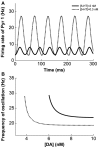Comodulation of dopamine and serotonin on prefrontal cortical rhythms: a theoretical study
- PMID: 23935568
- PMCID: PMC3733011
- DOI: 10.3389/fnint.2013.00054
Comodulation of dopamine and serotonin on prefrontal cortical rhythms: a theoretical study
Abstract
The prefrontal cortex (PFC) is implicated to play an important role in cognitive control. Abnormal PFC activities and rhythms have been observed in some neurological and neuropsychiatric disorders, and evidences suggest influences from the neuromodulators dopamine (DA) and serotonin (5-HT). Despite the high level of interest in these brain systems, the combined effects of DA and 5-HT modulation on PFC dynamics remain unknown. In this work, we build a mathematical model that incorporates available experimental findings to systematically study the comodulation of DA and 5-HT on the network behavior, focusing on beta and gamma band oscillations. Single neuronal model shows pyramidal cells with 5-HT1A and 2A receptors can be non-monotonically modulated by 5-HT. Two-population excitatory-inhibitory type network consisting of pyramidal cells with D1 receptors can provide rich repertoires of oscillatory behavior. In particular, 5-HT and DA can modulate the amplitude and frequency of the oscillations, which can emerge or cease, depending on receptor types. Certain receptor combinations are conducive for the robustness of the oscillatory regime, or the existence of multiple discrete oscillatory regimes. In a multi-population heterogeneous model that takes into account possible combination of receptors, we demonstrate that robust network oscillations require high DA concentration. We also show that selective D1 receptor antagonists (agonists) tend to suppress (enhance) network oscillations, increase the frequency from beta toward gamma band, while selective 5-HT1A antagonists (agonists) act in opposite ways. Selective D2 or 5-HT2A receptor antagonists (agonists) can lead to decrease (increase) in oscillation amplitude, but only 5-HT2A antagonists (agonists) can increase (decrease) the frequency. These results are comparable to some pharmacological effects. Our work illustrates the complex mechanisms of DA and 5-HT when operating simultaneously through multiple receptors.
Keywords: computational model; dopamine DA; nonlinear dynamics; prefrontal cortical circuit; selective dopamine and serotonin receptor agonist and antagonist; serotonin 5-HT.
Figures













Similar articles
-
Serotonin modulates fast-spiking interneuron and synchronous activity in the rat prefrontal cortex through 5-HT1A and 5-HT2A receptors.J Neurosci. 2010 Feb 10;30(6):2211-22. doi: 10.1523/JNEUROSCI.3335-09.2010. J Neurosci. 2010. PMID: 20147548 Free PMC article.
-
Serotonin modulation of cortical neurons and networks.Front Integr Neurosci. 2013 Apr 19;7:25. doi: 10.3389/fnint.2013.00025. eCollection 2013. Front Integr Neurosci. 2013. PMID: 23626526 Free PMC article.
-
Role of different monoamine receptors controlling MK-801-induced release of serotonin and glutamate in the medial prefrontal cortex: relevance for antipsychotic action.Int J Neuropsychopharmacol. 2009 May;12(4):487-99. doi: 10.1017/S1461145708009267. Epub 2008 Aug 28. Int J Neuropsychopharmacol. 2009. PMID: 18752722
-
Dopamine and serotonin interactions in the prefrontal cortex: insights on antipsychotic drugs and their mechanism of action.Pharmacopsychiatry. 2007 Dec;40 Suppl 1:S27-33. doi: 10.1055/s-2007-992133. Pharmacopsychiatry. 2007. PMID: 18080940 Review.
-
[Serotonergic control of prefrontal cortex].Rev Neurol. 2004 Sep 16-30;39(6):539-47. Rev Neurol. 2004. PMID: 15467993 Review. Spanish.
Cited by
-
Toward a multiscale modeling framework for understanding serotonergic function.J Psychopharmacol. 2017 Sep;31(9):1121-1136. doi: 10.1177/0269881117699612. Epub 2017 Apr 18. J Psychopharmacol. 2017. PMID: 28417684 Free PMC article. Review.
-
Sensory Processing in Rhesus Monkeys: Developmental Continuity, Prenatal Treatment, and Genetic Influences.Child Dev. 2017 Jan;88(1):183-197. doi: 10.1111/cdev.12572. Epub 2016 Jun 24. Child Dev. 2017. PMID: 27338151 Free PMC article.
-
Novel approaches to EEG and MEG in motor neurone disease: IFCN Handbook Chapter.Clin Neurophysiol Pract. 2025 Jul 11;10:301-315. doi: 10.1016/j.cnp.2025.07.001. eCollection 2025. Clin Neurophysiol Pract. 2025. PMID: 40726565 Free PMC article. Review.
-
Integrated dopaminergic neuronal model with reduced intracellular processes and inhibitory autoreceptors.IET Syst Biol. 2015 Dec;9(6):245-58. doi: 10.1049/iet-syb.2015.0018. IET Syst Biol. 2015. PMID: 26577159 Free PMC article.
-
Synaptic Interactions Between Serotonergic and Dopaminergic Systems in Parkinson's Disease.Curr Neuropharmacol. 2025;23(9):1021-1035. doi: 10.2174/011570159X336597241217062042. Curr Neuropharmacol. 2025. PMID: 39988779 Free PMC article. Review.
References
LinkOut - more resources
Full Text Sources
Other Literature Sources
Miscellaneous

